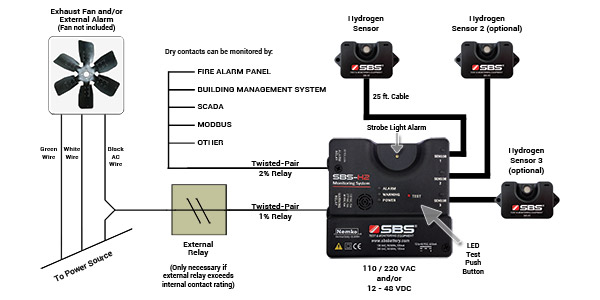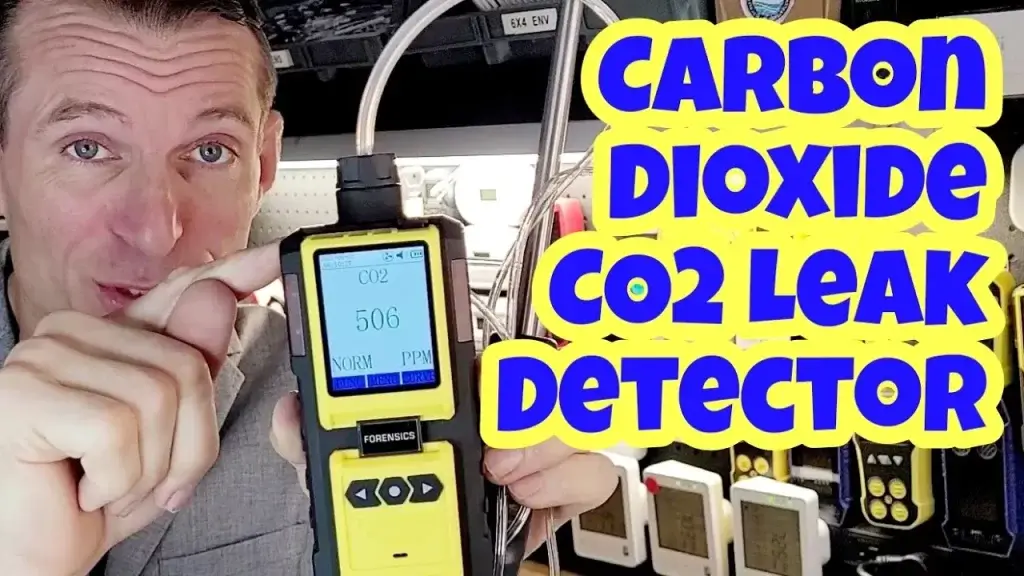Contents
- Causes Of Hydrogen Gas Release
- Chemical Reactions Within The Battery
- Overcharging Or Overheating Of Batteries
- Damage Or Aging Of Battery Components
- Consequences And Risks
- Fire And Explosion Hazards
- Effects On Human Health
- Environmental Impacts
- Methods Of Hydrogen Gas Monitoring
- Chemical Sensors
- Gas Chromatography
- Infrared Spectroscopy
- Electrochemical Sensors
- Safety Measures And Precautions
- Proper Ventilation And Monitoring Systems
- Regular Maintenance And Inspection Of Batteries
- Training And Awareness For Battery Operators
- Frequently Asked Questions
- How Is Hydrogen Gas Released From Batteries?
- Why Is Hydrogen Monitoring Important?
- What Are The Risks Associated With Hydrogen Gas Release From Batteries?
- How Can Hydrogen Gas Release From Batteries Be Controlled?
- Conclusion
Hydrogen gas release from batteries and hydrogen monitoring are important factors for safe operation. We will explore the reasons behind hydrogen gas release from batteries and the importance of monitoring this gas to ensure a safe environment.
As hydrogen gas is highly flammable and can lead to dangerous situations, understanding the causes of its release and implementing effective monitoring systems is crucial.
By adhering to strict safety protocols and using advanced monitoring technology, we can minimize the risks associated with hydrogen gas release and ensure the smooth operation of battery systems.
So, let’s dive deeper into the world of hydrogen gas release from batteries and the significance of hydrogen monitoring.
Causes Of Hydrogen Gas Release
Affordable and widely used, batteries are integral to our daily lives, powering everything from smartphones to cars. However, most people are not aware that batteries can release hydrogen gas, which can be potentially hazardous if not managed properly. Several factors contribute to the release of hydrogen gas from batteries:
Chemical Reactions Within The Battery
Batteries convert chemical energy into electrical energy through a series of reactions. These reactions involve the movement of ions and electrons within the battery, generating the desired power.
However, some of these chemical reactions can also produce hydrogen gas as a byproduct. For example, in lead-acid batteries, the charging process leads to the production of hydrogen gas.
Overcharging Or Overheating Of Batteries
Overcharging or subjecting a battery to excessive heat can trigger the release of hydrogen gas. When a battery is overcharged, the internal components can become stressed, leading to the breakdown of electrolytes and the subsequent release of hydrogen gas.
Similarly, high temperatures can accelerate the degradation of battery components, increasing the chances of hydrogen gas release.
Damage Or Aging Of Battery Components
As batteries age or sustain damage, their internal structure can deteriorate, creating conditions that promote hydrogen gas release. Physical damage or corrosion can compromise the integrity of the battery, allowing electrolytes to come into contact with reactive materials, which causes the formation of hydrogen gas.
Additionally, aging battery components can become less efficient at managing chemical reactions, leading to the release of hydrogen gas.
Understanding the causes of hydrogen gas release from batteries is crucial for implementing proper safety measures and monitoring.
By addressing issues related to chemical reactions, overcharging, overheating, damage, and aging, the risks associated with hydrogen gas release can be minimized, ensuring the safe and efficient use of batteries in various applications.

Consequences And Risks
The release of hydrogen gas from batteries can have serious consequences and risks. Understanding these risks is crucial for ensuring safety and taking appropriate measures to prevent any accidents or harm.
Fire And Explosion Hazards
Hydrogen gas, when released in sufficient quantities, can create a highly flammable and explosive environment. The presence of an ignition source, such as a spark or flame, can lead to a devastating fire or explosion.
Some key points to consider regarding fire and explosion hazards:
- Hydrogen gas is highly reactive and can ignite easily.
- It forms explosive mixtures with air at concentrations between 4% and 75%.
- Even a small release of hydrogen gas in an enclosed space can lead to a rapid buildup of flammable concentrations.
- Ignition sources can include electrical sparks, open flames, hot surfaces, or even static electricity.
Effects On Human Health
Exposure to hydrogen gas can have various health effects on individuals. It is important to understand and mitigate these risks to protect the well-being of people working with or in the vicinity of hydrogen gas-emitting batteries.
Key considerations related to the effects on human health:
- Hydrogen gas is not toxic on its own, but its presence can displace oxygen, leading to oxygen deficiency in confined spaces.
- In high concentrations, hydrogen gas can act as an asphyxiant, causing suffocation.
- Exposure to hydrogen gas may result in dizziness, nausea, shortness of breath, or other respiratory symptoms.
- People with pre-existing respiratory conditions may be more susceptible to the effects of hydrogen gas.
Environmental Impacts
The release of hydrogen gas from batteries can also have adverse effects on the environment. It is essential to consider these impacts and implement measures to minimize environmental harm.
Important points to note regarding the environmental impacts:
- Hydrogen gas is a greenhouse gas and contributes to climate change.
- When hydrogen gas is released into the atmosphere, it can displace oxygen and affect the balance of gases required for sustenance of life.
- In certain situations, the release of hydrogen gas can lead to air pollution and smog formation.
- Hydrogen gas can also accumulate in low-lying areas, posing risks to aquatic organisms and ecosystems.
Taking the appropriate precautions, such as implementing effective monitoring systems and ensuring proper ventilation, can help mitigate these risks associated with the release of hydrogen gas from batteries. By understanding the consequences and taking proactive measures, we can work towards a safer and more sustainable future.
Methods Of Hydrogen Gas Monitoring
Monitoring hydrogen gas release is crucial to ensuring safety in battery systems. Various methods can be employed to detect and measure the concentration of hydrogen gas in these environments. In this article, we will explore some commonly used methods of hydrogen gas monitoring.
Chemical Sensors
Chemical sensors are widely used for hydrogen gas monitoring due to their accuracy and reliability. These sensors operate on the principle of hydrogen gas reacting with a specific chemical compound, resulting in a measurable change.
The detection mechanism can vary, but the output is typically an electrical signal proportional to the concentration of hydrogen gas. Chemical sensors offer real-time monitoring and are suitable for both laboratory and field applications.
Gas Chromatography
Gas chromatography is another effective method for monitoring hydrogen gas release. This technique involves separating a gas mixture into its components using a stationary phase and a mobile phase. The separated components are then quantified using detectors such as flame ionization detectors (FID) or thermal conductivity detectors (TCD).
Gas chromatography provides high sensitivity and can accurately measure trace amounts of hydrogen gas. However, it requires specialized equipment and may not be suitable for continuous monitoring in certain situations.
Infrared Spectroscopy
Infrared spectroscopy is a non-contact method for detecting and quantifying hydrogen gas. This technique relies on the absorption of infrared radiation by hydrogen gas molecules, resulting in distinct absorption patterns. By analyzing the absorption spectrum, the concentration of hydrogen gas can be determined.
Infrared spectroscopy offers fast and accurate measurements, making it a valuable tool for hydrogen gas monitoring. However, it may be limited by interference from other gases and requires periodic calibration to maintain accuracy.
Electrochemical Sensors
Electrochemical sensors are widely used for hydrogen gas monitoring due to their sensitivity and low cost. These sensors operate by measuring the electrical current produced during the electrochemical reaction between hydrogen gas and an electrode.
The current is proportional to the concentration of hydrogen gas and can be converted into a measurable signal. Electrochemical sensors are portable, easy to use, and provide continuous monitoring capabilities. However, they may be affected by humidity and require periodic calibration and maintenance.
By employing these methods of hydrogen gas monitoring, battery systems can ensure early detection and response to potential safety hazards. Whether utilizing chemical sensors, gas chromatography, infrared spectroscopy, or electrochemical sensors, choosing the appropriate monitoring method depends on factors such as accuracy requirements, budget constraints, and operational conditions.

Safety Measures And Precautions
When dealing with hydrogen gas release from batteries and implementing hydrogen monitoring systems, certain safety measures and precautions must be followed to mitigate potential risks and ensure a secure working environment. The following H3 headings outline key considerations for maintaining safety.
Proper Ventilation And Monitoring Systems
Proper ventilation is crucial when handling batteries that produce hydrogen gas. Adequate airflow helps to reduce the concentration of hydrogen gas in enclosed spaces, minimizing the risk of ignition and potential hazards. Implementing a well-designed ventilation system in battery storage rooms or facilities is essential to ensure the dissipation of hydrogen gas.
Besides ventilation, installing hydrogen monitoring systems adds an extra layer of safety. These systems continuously detect and measure hydrogen levels in the air, providing real-time data on potential gas leaks or accumulation.
By promptly identifying any rise in hydrogen concentration, these monitoring systems enable prompt action for preventing accidents and addressing potential issues efficiently.
Regular Maintenance And Inspection Of Batteries
Regular maintenance and inspection of batteries are critical for ensuring their proper functioning and reducing the risk of hydrogen gas release. Routine checks should include verifying the overall condition of batteries, checking for any signs of leakage or corrosion, and ensuring proper connections. Identifying and addressing any issues promptly not only decreases the likelihood of hydrogen gas generation but also prolongs battery lifespan and performance.
Furthermore, following manufacturers’ guidelines for maintenance procedures and schedules is vital. This helps to prevent any potential hazards caused by neglect, such as overcharging or improper handling, which can lead to hydrogen gas release from batteries.
Training And Awareness For Battery Operators
Equipping battery operators with the necessary knowledge and awareness is crucial in maintaining safety. Proper training should be provided, covering handling and maintenance procedures specific to the batteries being used and the associated risks, including hydrogen gas release.
Operators should be educated on preventive measures, emergency protocols, and how to use monitoring systems effectively.
Regular refresher courses and updates on safety practices should be mandatory to ensure that operators stay informed about the latest guidelines and best practices. By prioritizing training and raising awareness, organizations can minimize the potential for accidents, creating a safer working environment.
Frequently Asked Questions
How Is Hydrogen Gas Released From Batteries?
Hydrogen gas can be released from batteries due to a chemical reaction that occurs when the battery operates. As the battery charges and discharges, hydrogen gas is produced as a byproduct. This gas can escape through vents or openings in the battery casing.
Why Is Hydrogen Monitoring Important?
Hydrogen monitoring is crucial for safety reasons. Hydrogen gas is highly flammable and can be dangerous if not properly monitored. By regularly monitoring hydrogen levels, potential hazards can be identified and preventive measures can be taken to ensure the safety of the surroundings.
What Are The Risks Associated With Hydrogen Gas Release From Batteries?
The main risk associated with hydrogen gas release from batteries is the potential for explosions and fires. If hydrogen collects in a confined space and reaches its flammable limits, it can ignite when exposed to a spark or flame. Regular monitoring and proper ventilation are necessary to mitigate these risks.
How Can Hydrogen Gas Release From Batteries Be Controlled?
Controlling hydrogen gas release from batteries can be achieved through various measures. This includes utilizing battery designs with improved ventilation systems, implementing proper battery maintenance and inspection procedures, ensuring adequate air circulation in the battery storage area, and using hydrogen monitors to detect and respond to any gas buildup promptly.
Conclusion
Hydrogen gas release from batteries is a crucial factor to consider, as it poses potential safety risks. Implementing hydrogen monitoring systems ensures early detection and prevention of hazardous situations. With advancements in technology, monitoring solutions have become more efficient and reliable.
By understanding the importance of hydrogen gas release and utilizing monitoring tools, we can maintain a safe and sustainable environment.







